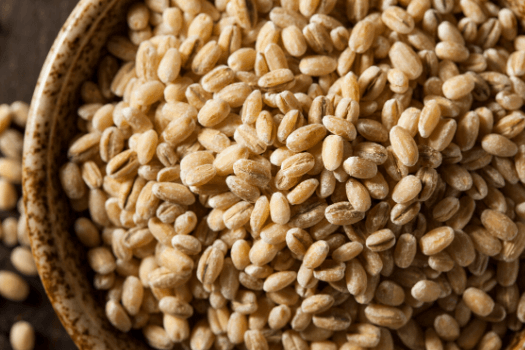
December 24, 2019 2 min read 2 Comments
 There is a fair amount of confusion among our customers about the best kind of organic barley to use, not surprising as the differences can be subtle. Over time, we have seen three main kinds of organic barley become available: Classic "Hulled Barley", Pearled Barley, and the lesser-known "Hull-less Barley".What we would call classic Hulled Barley is a variety of barley with an outer husk that is tightly attached. To make the grain edible, this tight outer husk, or ‘hull’, is removed using a kind of simple rolling/tumbling action. This processing is similar but shorter to what is done to create Pearled Barley. The resulting grains do bear a slight resemblance to each other visually and can cause confusion for people choosing a product. For example, classic Hulled Barley will show some of the bare spots common to Pearled Barley from all the rolling/tumbling. But importantly, the shorter processing means Hulled Barley retains a higher nutrition level.
There is a fair amount of confusion among our customers about the best kind of organic barley to use, not surprising as the differences can be subtle. Over time, we have seen three main kinds of organic barley become available: Classic "Hulled Barley", Pearled Barley, and the lesser-known "Hull-less Barley".What we would call classic Hulled Barley is a variety of barley with an outer husk that is tightly attached. To make the grain edible, this tight outer husk, or ‘hull’, is removed using a kind of simple rolling/tumbling action. This processing is similar but shorter to what is done to create Pearled Barley. The resulting grains do bear a slight resemblance to each other visually and can cause confusion for people choosing a product. For example, classic Hulled Barley will show some of the bare spots common to Pearled Barley from all the rolling/tumbling. But importantly, the shorter processing means Hulled Barley retains a higher nutrition level.
As you may have guessed, Pearled Barley gets its name from the pale shine created from longer tumbling times when processing. These longer times mean that not only is the outer hull removed but also most of the bran layer (which is the fiber). This extra processing creates a grain that is less chewy and cooks more quickly. Pearled Barley is also sometimes called ‘Pot or Scotch’ barley. Pearled Barley is the most processed, least beneficial of the 3 options from a nutrition perspective. That said, organic Pearled Barley is still a healthy ingredient if you prefer your barley this way as it still retains its protein, vitamin, and mineral content.
Whereas Hulled Barley and Pearled Barley are the same species and get their names from the way they are processed, Hull-less Barley, often called Hulless Barley, is actually a completely different variety of barley. This species has an outer hull that is much less tightly attached and therefore drops off on its own as it is harvested in the field. Being a different variety, and not requiring any rolling/tumbling, it looks different to the naked eye. There are some cooking and taste differences as well. We will go into this aspect a bit more in part 2 of this series.
Recipes:
Related Blogs:
Thanks for reading this Be Still Farms Blog article. To sign up for more news/articles and/or recipes, click here. For more about us, click here. To shop our certified organic products, click here.
Please comment and share and we look forward to serving you in the future!
April 28, 2020
Where do I find part two of this article on pearl, hulled and hulless barley?
Comments will be approved before showing up.

January 27, 2025 3 min read
Flaxseed, the tiny yet powerful superfood, is packed with nutrients that can support weight loss. From curbing hunger to stabilizing blood sugar, this guide dives into the science of how flaxseed can help you shed those extra pounds.

December 11, 2024 3 min read
Discover three quick and easy soup recipes featuring organic small red beans. From a classic vegetable soup to a creamy potato blend, these wholesome recipes are perfect for chilly days and busy weeknights. Packed with flavor and nutrition, these soups will warm your heart and soul this winter!

December 06, 2024 3 min read
This vibrant and nutritious Green Lentil Salad combines tender lentils with grilled chicken, fresh vegetables, and a zesty lemon dressing. Packed with protein, fiber, and essential vitamins, it’s the perfect healthy meal for any time of day.
© 2025 Be Still Farms- Real, Fine Organics.
Privacy | Terms | Refund Policy | Organic Certification

Michelle McNamara
June 03, 2020
Hi There!
You can find part two of that article here:
https://be-still-farms.com/blogs/healthy-organic-living-blog/why-barley-part-2-cooking-taste
Blessings!
Michele @ Be Still Farms
The Carolinas